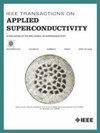Bending Strain Dependence of Critical Current in BSCCO and REBCO Tapes
IF 1.8
3区 物理与天体物理
Q3 ENGINEERING, ELECTRICAL & ELECTRONIC
引用次数: 0
Abstract
Applying BSCCO and REBCO tapes to various engineering purposes, three modes of tensile and edgewise- and flatwise- bending are essential to deform the tape in pancake and spiral windings as well as twisting. Both kinds of tape consist of brittle superconducting (SC) oxide and several metallic components. Fine SC filaments are embedded in Ag matrix in BSCCO tape while single SC layer is put on the metallic sheet in REBCO one. These texture difference influences clearly on the bending dependence of critical current (BSCCO和REBCO带中临界电流的弯曲应变依赖性
将BSCCO和REBCO胶带应用于各种工程用途,三种拉伸和边缘和平面弯曲模式对于使胶带变形为煎饼和螺旋缠绕以及扭曲是必不可少的。这两种胶带都由脆性超导氧化物和几种金属成分组成。在BSCCO带中,细SC细丝嵌入银基体中,而在REBCO带中,单SC层嵌入金属薄片上。这些织构差异明显影响临界电流(Ic)的弯曲依赖性。当BSCCO带被平弯至~ 53 mm,被斜弯至1325 ~ 1682 mm时,其Ic降低到Ic0/Ic00的95%。临界电流退化开始时,等效平面弯曲应变为0.29% ~ 0.39%,临界边缘应变为0.29% ~ 0.31%。在REBCO胶带的情况下,Ic没有减少高达10毫米的平面弯曲,而它减少了405毫米的边缘弯曲。沿向弯曲应变从1.04%开始降解,而沿向弯曲应变不降解,降解率高达0.92%。讨论了BSCCO和REBCO带的断裂行为。降解始于BSCCO细丝的断裂,而它起源于REBCO带中氧化物和金属界面之间的分层。
本文章由计算机程序翻译,如有差异,请以英文原文为准。
求助全文
约1分钟内获得全文
求助全文
来源期刊

IEEE Transactions on Applied Superconductivity
工程技术-工程:电子与电气
CiteScore
3.50
自引率
33.30%
发文量
650
审稿时长
2.3 months
期刊介绍:
IEEE Transactions on Applied Superconductivity (TAS) contains articles on the applications of superconductivity and other relevant technology. Electronic applications include analog and digital circuits employing thin films and active devices such as Josephson junctions. Large scale applications include magnets for power applications such as motors and generators, for magnetic resonance, for accelerators, and cable applications such as power transmission.
 求助内容:
求助内容: 应助结果提醒方式:
应助结果提醒方式:


